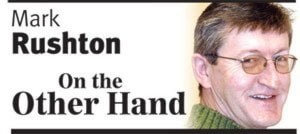Strange as this may sound, I did this past week embrace Abbotsford’s tree protection program – well, at least I spoke civilly to the city’s chief forester, and in fact requested him to tour my property.
Oddly enough, following a heated public meeting over the tree bylaw a couple of weeks ago, I was talking to my neighbour in the driveway when he observed that the very large Lombardy poplar in my front yard was looking sickly. I dismissed it as a quirk of light on the leaves.
On closer inspection, yes, the leaves were turning brown. A few days later the entire tree was as red-brown as the beetle-killed pines of the Cariboo. My tree was dying.
And then I noticed all the poplars along my back fence were an equal shade of death.
The trees, it appeared to me, should be removed, but since I do try to play by the rules, I contacted the city and asked the forester to give me his opinion, and tacit approval to break out the chainsaw.
The conclusion of the visit was that the trees were severely diseased, and should be removed before they fully wither and fall on my house or, more importantly, me.
The disturbing aspect, however, was not having to “seek permission” to cut down my own trees so much as why so many trees were dying. Thus, I also contacted the Ministry of Environment, which has promised to look into the cause on my property.
Not only are all the Lombardy poplars in their death throes, so too are a couple of weeping willows and a mimosa. And last year two other trees of different species bit the dust.
Is there something in my soil that is deadly, or is there something in the air around here? Hopefully someone from the MoE can determine that.
In the meantime, I looked at the poplars on nearby Ledgeview Golf Course. Leaves are brown on them too, covering the fairways as though it was fall.
Blight, or possibly other airborne diseases, appears to be widespread here on the mountain and is killing our trees.
The 120-footer, 75 feet from my house, will require professional removal. The other 30 or more poplars, most at least 100 feet tall (if you only understand metric, break out your converter), will fall to my own saw.
The sad part is these trees have adorned my property for some 35 years, and were virtual saplings when I acquired the property in the mid-1980s. They have always appealed to me, though I must admit I have been concerned that the biggest one would come down on my house in a severe windstorm.
Fortuitously, the demise of the trees has intervened before a call to my insurance company became necessary.
So while I will, over the next few weeks, source enough firewood to last me well into the next decade, and lament the loss of the trees, the desire to have the tree protection bylaw repealed has not diminished.
Dead and dying trees, or live ones that have simply grown too large are still, on urban lots or acreage, our trees to determine what we want to do with them.
They are not part of the “common good.”
And besides, it is not the private resident who has the need or desire to cut trees willy-nilly. That generally occurs only for development properties being put to use for industrial, commercial or subdivision purposes, and the city already has bylaws in place to control and reforest those activities.
The city also has laws in place regulating “common” lands such as street boulevards and parks, thus rendering a tree bylaw on private property redundant.
In the meantime, tempered by sadness at the loss of my trees, the song of the saw will ring loud and long on my property this summer.
markrushton@abbynews.com
